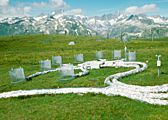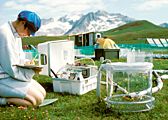Alpine ecosystems and elevated CO₂
Plant photosynthesis depends on CO2. The lesson on carbon relations has made it clear that there is no evidence that alpine plants are short of carbon. In order to test the C-limitation hypothesis, alpine grassland at 2500 m in the Swiss Alps was exposed to twice the current CO2 concentration for 4 seasons.
The results confirmed the C-saturation hypothesis. Elevated CO2 caused:
- no change in growth or biomass production per unit land area
- an increase in the carbon to nitrogen ratio in plant tissue (diminished tissue quality; more carbohydrates, less protein)
- compensatory feeding (increased intake) by the major natural herbivore (grasshopper)
- differential responses of plant species, which could, in the very long run, change community structure and ecosystem functioning.
It is concluded that the enrichment of the atmosphere with CO2 will exert little direct influence on late successional alpine biota. There is a possibility that small species specific reponse differences and plant-animal interactions will translate into longer term biodiversity effects. However, other environmental changes are likely to mask such CO2 effects. No data are available for alpine pioneer vegetation, which may be more responsive given their better access to nutrients. The indirect effects of atmospheric CO2-enrichment via enhanced greenhouse forcing will be discussed later.




